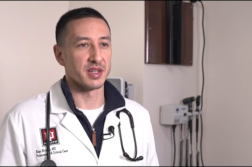NEW JERSEY (Ivanhoe Newswire) – When someone suffers a severe spinal cord injury, most of us think of the impact on their arms and legs. But spinal cord injuries often affect breathing. In fact, breathing issues are the number one cause of death for a person with spinal cord injury. A New Jersey surgeon has pioneered a specialized procedure that restores the ability for some injured patients to breathe on their own again.
At age 29, William “Buddy” Marshall was living his childhood dream. After eight years as a naval aviator, he had just become a Top Gun instructor. His call sign was “Hipster.”
But six months into his new position, a driver fleeing police slammed into Buddy’s car at 100 miles an hour. He doesn’t even remember the accident.
“My day-to-day memory didn’t come back for about a month,” Buddy recalls.
The damage was done. He was paralyzed from the neck down and needed a ventilator to breathe. Dr. Matthew Kaufman, MD, FACS, a reconstructive surgeon at the Hackensack Meridian Jersey Shore University Medical Center, is a pioneer in a specialized surgery that helps injured people breathe more easily by repairing the delicate phrenic nerves that run on either side of the diaphragm.
“The phrenic nerve’s job is to transmit the electrical impulse from our brain to cause the diaphragm to contract and to allow the lung to fill with air.,” Dr. Kaufman explains.
Using microscopic sutures, Dr. Kaufman reconstructed the nerves, which are the size of a strand of spaghetti.
Dr. Kaufman says, “Basically, we can get nerves to work again, similar to doing electrical rewiring in your house.”
In Buddy’s case, surgeons also implanted a stimulator to treat the diaphragm muscle and help it contract. While Buddy hasn’t regained mobility in the seven years since the accident, the phrenic nerve graft has improved his quality of life.
“Just the ease of living with spinal cord injury and being able to be off the vent when I need to is huge. You just have to take it day by day and aim for the good days,” Buddy emphasizes.
Buddy says he is not completely off the ventilator but has peace of mind knowing he is breathing without machinery. By the way, Buddy says his squadron gave him his call sign “Hipster” because he loved alternative music and good coffee.
Contributors to this news report include: Cyndy McGrath, Producer; Kirk Manson, Videographer; Roque Correa, Editor.
To receive a free weekly e-mail on medical breakthroughs from Ivanhoe, sign up at: http://www.ivanhoe.com/ftk
Source:
MEDICAL BREAKTHROUGHS
RESEARCH SUMMARY
TOPIC: TOP GUN INSTRUCTOR: BREATHING BETTER AFTER BREAKTHROUGH SURGERY
REPORT: MB #5078
BACKGROUND: A spinal cord injury (SCI) is damage to the tight bundle of cells and nerves that sends and receives signals from the brain to and from the rest of the body. SCI can be caused by direct injury to the spinal cord itself or from damage to the tissue and bones (vertebrae) that surround the spinal cord. Motor vehicle accidents and catastrophic falls are the most common causes of SCI in the United States. Approximately 17,810 new spinal cord injuries occur each year in the USA. Males account for about 78% of new SCI cases.
DIAGNOSING: Your ability to control your limbs after a spinal cord injury depends on two factors: where the injury occurred on your spinal cord and the severity of injury. Your health care team will perform a series of tests to determine the neurological level and completeness of your injury. Spinal cord injuries can cause one or more of the following signs and symptoms: loss of movement, loss of or altered sensation, including the ability to feel heat, cold, and touch, loss of bowel or bladder control, exaggerated reflex activities or spams, changes in sexual function, sexual sensitivity and fertility, and difficulty breathing, coughing or clearing secretions from your lungs.
(Source: https://www.mayoclinic.org/diseases-conditions/spinal-cord-injury/symptoms-causes/syc-20377890)
NEW TECHNOLOGY: For decades, scientists have looked for an effective treatment for spinal cord injuries, often with little success. Now, new research by Northwestern University scientists has resulted in a game-changing innovation: an injection that uses “dancing molecules” to repair spinal tissue and reverse paralysis. The treatment has already been shown to work in mice. Paralyzed mice regained their ability to walk four weeks after an injection of the new treatment. Injected as a liquid, the molecules came together in a solution to form tiny fiber structures (called nanofibers) that surrounded the spinal cord. The researchers discovered that the motion of molecules within the nanofibers could be controlled by changing their chemical structure. It turned out that molecules that moved most — “danced” more — were more likely to signal cells via proteins called receptors, resulting in a more effective treatment. Samuel Stupp, a professor of materials science and engineering, chemistry, medicine, and biomedical engineering at Northwestern who led the study, is already in the process of applying for FDA approval to test the therapy in human subjects who have few other treatment options.
FOR MORE INFORMATION ON THIS REPORT, PLEASE CONTACT:
Edna Arguello
(201) 525-8833
If this story or any other Ivanhoe story has impacted your life or prompted you or someone you know to seek or change treatments, please let us know by contacting Marjorie Bekaert Thomas at mthomas@ivanhoe.com




